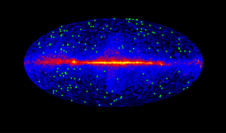We're open daily! View holiday hours
Science News
Fermi Cosmic Fog
November 14, 2012
by Josh Roberts

When we look out in to the Universe, we see light emitted by nearby stars. Stars are fundamental building blocks of the observable Universe. Finding out how and when stars first formed helps astronomers understand how our universe came to be. In order to study the rate of star formation over time, the Fermi telescope (named for the famous physicist Enrico Fermi) has been observing very intense sources of high- powered gamma radiation astronomers know as “quasars.”
Quasi-stellar radio sources (or quasars for short) are the incredibly bright cores of young galaxies that shoot off narrow beams of gamma radiation in opposite directions. If we happen to lie in the path of one of these photon streams, Fermi takes note of the amount of energy observed and where it came from.
How do these distant galaxies tell us how and when stars form? Starlight acts on this gamma radiation much like fog acts on a lighthouse beam. When the starlight photon bumps into a gamma photon coming towards us from the quasar, they wipe each other out, leaving behind an electron and its opposite, a positron. Thus, the gamma photon does not make it to the telescope to be observed.
In this way, the amount of light from quasars blocked by starlight tells us how much starlight exists in the Universe. As astronomers find more and more distant quasars, they can peer into earlier ages of the Universe and determine the rate of star formation at that time. In fact, by understanding these distant objects, the Fermi scientists determined when the earliest star formation took place. And given our understanding of stellar evolution, we can calculate the density of stars within our universe. If stars were distributed evenly across all of space, the distance between them would be approximately 4150 light years; with a meager 1.4 stars per billion cubic light years! For comparison, our nearest star lies a mere 4.3 light years away, so we live in a part of the Universe much denser than “average.”
Since its launch in 2008, Fermi has been conducting cutting edge science, exploring the nature and composition of galaxies both near and far. Its discoveries set the stage for the upcoming James Webb Space Telescope to peer even farther and to obtain a finer image of the early Universe and a better understanding of our place within it.
Josh Roberts is a program presenter and astronomer at the California Academy of Sciences. He also contributes content to Morrison Planetarium productions.
Image: NASA/DOE/Fermi LAT Collaboration